MySpace. The next “Fucking Merlot.”
Posted in: UncategorizedIt’s sad when the shunning starts. Funny interpretation of Internet brands as your friends and neighbors.
Spotted at the one and only Dear Jane Sample.
It’s sad when the shunning starts. Funny interpretation of Internet brands as your friends and neighbors.
Spotted at the one and only Dear Jane Sample.
A futuristic spot from Lacoste to celebrate its 75th anniversary and its founder’s extraordinary inventiveness.
Can you imagine how tennis will be played in the future, 75 years from now? You, new technology and a wall.
A simple and futuristic ad that works on many levels from the art direction to the computer animation.
More on their mini site.
Studio: Akama
Production: Wanda
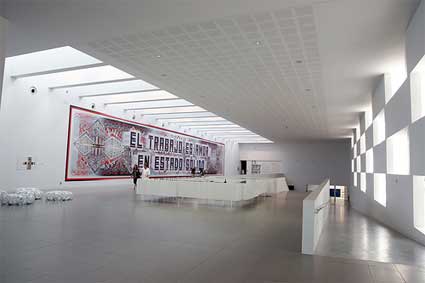
LABoral (inside) mural by Mark Titchner. Image courtesy of LABoral
Together with Erich Berger and Laura Baigorri, Daphne Dragona curated Homo Ludens Ludens, an exhibition about play in contemporary culture and society which runs until September 22 at LABoral, Spain. I’ve been blogging the exhibition over the past few days but i wanted to end the coverage with a couple of questions to Daphne.
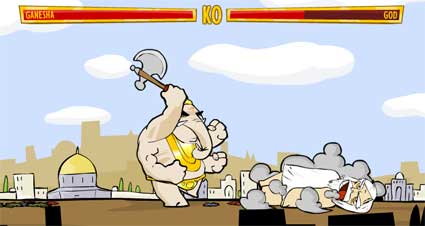
Daphne Dragona is an independent new media arts curator and organiser, based in Athens with a special interest in the game arts field. She was the Programme Curator of Gaming Realities (Medi@terra, International Art and Technology Festival) which took place in Athens in 2006, and the Associate Curator of Gameworld which was hosted in Laboral in 2007. She has been involved as an organiser or as a participant in different new media events and since 2004 she is also collaborating with the International New Media Collective Personal Cinema.
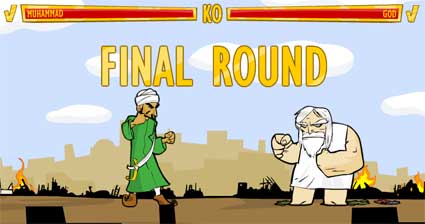
Molle Industria, Faith Fighter
Following Gameworld and Playware, Homo Ludens Ludens is the last episode of a trilogy dedicated to the world of game. How different is HLL’s take on the theme of games and play?
We wanted Homo Ludens Ludens to embrace the previous concepts and summarize them somehow. To do this we needed to take in a way a step back, to look into play rather than games, to locate play’s role and significance into the different sections of our society and culture. The two previous exhibitions, Gameworld and Playware focused respectively on the creativity of gaming art and on the playfulness of interactive art. Homo Ludens Ludens tried to locate and present play as a power and a medium that is embodied in different sections of our lives, that can ask questions, reveal facts and bring changes.
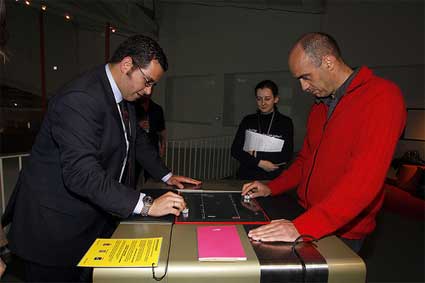
PainStation. Image credit: LABoral/Enrique G. Cárdenas
HLL presented 4 different themes: previous art movements which incorporated play in their discourse, play in everyday life, contents which invite to reflect on political and social issues and finally an introspective look on games and video games. Why did you decide to adopt such a broad approach?
Well, truth is that there are much more themes being discussed. We referred to these 4 categories at some point because the need appeared, as it happens for all exhibitions, to speak of a particular kind of structure. But in reality we were against the idea of grouping and categorising. Works can be categorised according to this scheme or some other schemes. The form of the exhibition is quite fluid actually, with no rigid clusters and units. To come back to your question, yes the theme is broad, but the issue of play in our digital times is huge anyway. Naming the event Homo Ludens Ludens was in a way an intro for a broad approach. Huizinga was already talking about the diffusion of play within culture back in the late 30s. We wanted to explore and present how things have changed, flourished and altered since then; to bring in as many aspects as possible through our exhibition and our conference. There have been a lot of misunderstandings regarding play nowadays: for instance, you speak about play and everyone things you refer to videogames, you refer to play and the issue is considered merely joyful, entertaining and lacking content. We wanted to escape from this, to present play’s multifaceted character and raise consciousness about it. So, the approach could have been even broader, but maybe then the risk of its good presentation and perception would be higher.
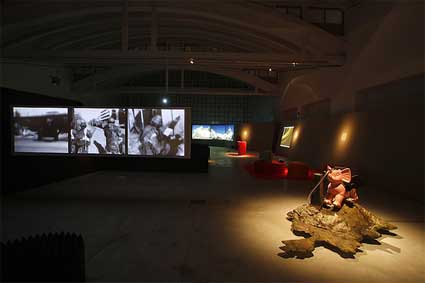
Image courtesy of LABoral/Enrique G. Cárdenas
Which strategies did you adopt to have works which have very different backgrounds and characteristics (the interview with Muciunas, the installation levelHead, the Objects of Desire chase, etc.) cohabit and dialog with each other? You and your fellow curators Erich Berger and Laura Baigorri must have met with many challenges when preparing such a big and multi-faceted show. How did you manage to keep your head(s) above the water?
I would not really speak of strategies. Let’s say that we located the areas of our interest on one hand, and works we consider interesting and inspiring on the other. We knew that we wanted to have a show that would be playful and critical at the same time. The criterion for all cases of works was not their form, for instance to be game applications as it happens in most game art shows, but rather their playfulness, their ludic mode and the ability to express different situations and notions through it. There were no constraints regarding any types of works – the exhibition was to be explored as a territory, a playground of various contemporary magic circles. This is maybe where the challenge and the difficulty was: trying to avoid usual paths and groupings that exhibitions tend to follow and still aiming to have a perceivable context and content. This is how we came up with dialogues and adjoining of certain works that were implied but not explained or framed. I believe that this kept the flow much smoother and more open.
So this way, for example, Wegman‘s dogs could go next to Stockburger‘s Tokyo gamers to show play’s omnipresence and utter seriousness; Ludic Society‘s chase based on the desires of particular objects and Savicic’s wifi map of gijon as read by his special corset could be adjoined by a magnified copy of Debord‘s psychogeographical map of Paris; Klima‘s pink elephant on the war of Afghanistan could sit next to Sanchez’s Atari modification for the civil war of Peru.
Regarding the references to the old movements of the fluxus and the situationists we felt like we ought to include them, not only as a “tribute” to them but also as an additional element for the audience to perceive the contemporary works we present. For instance, it is important to see that certain notions that are presented in this show such as those of the transdisciplinarity, the appropriation, the detournement, the idea of highlighting the importance of everyday life as opposed to art, they all have their roots way back, in important modern movements.
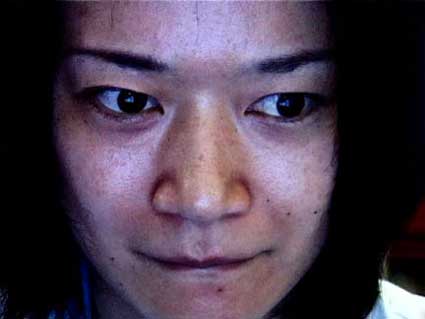
Axel Stockburger, Tokyo Arcade Warriors – Shibuya (2005)
Many of the works on show at HLL demonstrate a keen observation of the rules and mechanisms of commercial games but do you think that the opposite is true? Have you ever noticed any interest from the commercial scene for what artists are doing with the game medium?
My understanding is that they do follow what happens in terms of creativity. The innovations and the approaches that are often introduced by artists and independent creators are of their interest either in terms of design, content or programming. And they do tend to hire artists often as part of their team, which makes sense of course. But on the other hand, judging from my experience, game companies still hesitate to support game art exhibitions, festivals and conferences. The commercial and the independent/artistic scene have not really merged yet. Probably they are not meant to merge, if we take what happened with cinema as an example. Different works and productions attract different audiences. Not a lot of gamers go to game art exhibitions for instance. The audience for these shows is mainly people interested in the arts and the technology. But at the end, it all works perfectly well for the industry as games are assigned new roles and are being accredited new values. This is the tricky point. As Auriea Harvey and Michael Samyn had said, how about if the artistic / independent gaming scene at the end becomes the alibi for the commercial one to keep its character intact?
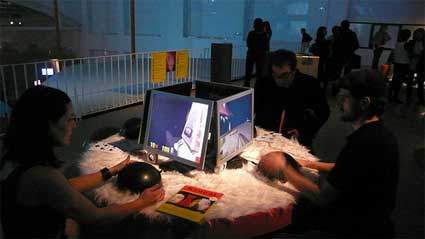
France Cadet, SweetPad
If i’m not wrong, you distinguish play from game. Can you explain us what makes them different from each other?
Yes, we tried to make this distinction visible in Homo Ludens Ludens, although there is no “formal” differentiation between the two terms and there is of course a lot of overlapping. In reality, it is easy to describe games but rather difficult to frame play.
I would say play reflects more the idea, the notion, the vivid and spontaneous basis for the action as well as its relation to fantasy, whereas games are closed systems and environments governed by rules which demand discipline and a constraint space and time. Play is in a way the presupposition for the games that are its expressions and forms.
Play as a notion is much more open and therefore it may even embrace elements that come in opposition with a game’s structure. For instance play has no death or end; but games do, otherwise there s no meaning into it. Or think of cheating. While it can destroy a game by breaking its rules, it is still a part, an act of play. On the same line, while any game forms hierarchies, play creates interrelations between them.
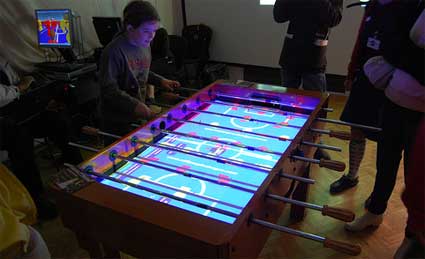
MIT Lab – Drew Harry, Dietmar Offenhuber, Orkan Telhan Stiff People’s League
It is all up to the play instinct I guess. We can be playful anytime anyplace, not only through games. Games are basically a construction which is made possible because of this playfulness that already exists in any aspect of life.
Nowadays, with the explosion of the videogame industry games have also become a product, a commodity and a subject of control. Accordingly, play became work and life itself started looking more like a complicated game environment. So the question is what happens with the notion of play at such times? This is really interesting: how we have been led from the total invasion of play that the situationists were dreaming of to the gamespace phenomenon Wark describes.
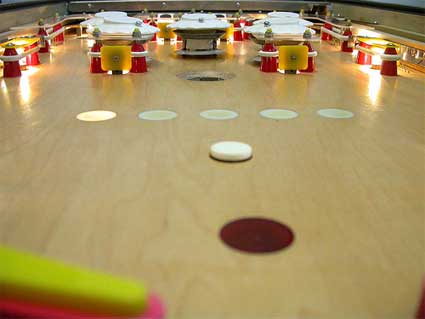
Martin Pichlmair & Fares Kayali Bagatelle Concrete
What is your personal relationship with video games? Are you a gamer yourself?
I mostly enjoy following what s happening in the online virtual worlds and trying out practices and applications by the independent and artistic scene. I also do try to keep up with the commercial games popping up but sometimes this is not so easy in terms of time and energy. Generally, however, if you ask me about the last months, I must say that -maybe influenced by homo ludens ludens- I also got carried away and inspired by other types of play; from children’s make believe play to play being approached by philosophy as a tool for political change… This practically means that I really liked playing a lot with my 2 year old niece on one hand and reading Agamben and Vaneigem on the other. It was quite a weird combination now that I think about it…
Thanks Daphne!
This is an anti-violence campaign, that ironically promoting the extremely violent game Condemned 2 on Xbox 360.
Condemned 2 is the second title in the series. In the game you are Ethan Thomas, a disgraced member of the Serial Crimes Unit who is unstable and one drink short of self destruction. The game includes brutal in your face combat including combo attacks and over the top “finishing moves”. The game is most definitely not mainstream, it is for a niche audience of ‘hardcore’ gamers.
The communication challenge: find a fresh and engaging way to connect with the target, who are used to companies just re-skinning a site with game footage, and, think they have seen everything there is to see when it comes to the ‘shoot‘em-up’ genre.
Hardcore Gamers (typically male), 18-30yo. Tend to be cynical, curious by nature, like problem solving and challenges, and spend their life in the online gaming world.
We know that playing Condemned 2 is a brutal, blunt experience and it seems that Sega does too. OffSetTheEvil.com allows you to balance your karma by “offsetting the evil” much like you would with your carbon footprint. Thankfully, offsetting evil doesn’t cost a penny – instead you simply need to explore the sickly sweet saturday-morning cartoon of a website.
Once there you can make yourself feel less wicked by playing a ridiculous flash game involving helping horse across a river. Don’t worry if they fall in, though. They still love you! If that’s not for you then explore the Forest of Fairy Flowers, with hidden links to sites which will teach you to dance or show videos of the Teletubbies. There’s plenty more content to reduce your sin footprint included on the site. If you can handle it, that is.
The creative execution is made up of 3 x virals ‘Pony Heart Quest’, ‘Clown Flower Time’ and ‘Lollipop Gift Parade’. These virals drive you to the website www.offsettheevil.com. Once on the website you can play 3 x games based on the virals.
Online banners are also going to be run on IGN.com and Gamespot. One of the banners (300 x 600) is going to be a game in itself called Panda Rainbow Delight.
It remind me a little of “Happy Tree Friends” but the purpose is different.
Many thanks to Giorgi Ciot for sending these creative materials.
AGENCY TEAM:
Creative Team – Michael Dawson, Chris Berents
Executive CD: Richard Maddocks, Associate CD: Guy Rooke
Account Service – AM: Adam Levee, GAD: Rob Nichol
Digital Designer – Brett Bimson, Kevin Phillips
Designer – Gustavo Vampre
TV producer – Denise McKeon
Digital Producer – Harley Tesoriero
Editor – Joe Morris
Sound Design – Andrew Stevenson
PRODUCTION HOUSE:
Yukfoo Animation, Auckland
Director – Julian Stokoe
Producer – Glen Real
MUSIC:
Liquid Studios, Auckland
Creative Director – Peter Van Der Fluit
Composer – Max Scott
Engineer – Matt Scott
Producer – Dee Taylor
AdmCom launches YOC, a self promotion initiative designed to make 2008, the Official Year of Creativity.
A series of proposals ranging from web activities to direct marketing, and from unconventional inspiration to press campaigns that starts from everyday affairs and people and finishes by touching the world of advertising communications.
YOC – the Official Year of Creativity – is an initiative launched by AdmCom to dedicate 2008 to the exploration of the infinite potential of creative energy. The project includes a series of messages and opportunities embracing different forms and media designed to be both “used” and invented by the people contacted.
“Be the change you want to see in the world”, this is the idea behind YOC_BOX, the first in a series of initiatives launched by AdmCom.
An unusual self promotion tool, YOC_BOX is a box containing 366 ironic, surreal and provocative business cards. Each of the cards, which are personalized with the name of the person they are sent to, carries, in highly original graphics, an impossible profession or an imaginary role that we have all dreamed of, or perhaps, would simply enjoy doing for a day. This everyday object has therefore been destructured and reinvented in order to revolutionize the labels and habits that others see when they look at us or that we ourselves see when we look in the mirror.
The concept behind YOC_BOX is also at the heart of YOC_CLICK, the site at www.yearofcreativity.com where you can view the 366 business cards. All the cards, which can be personalized with your own name and downloaded completely free of charge, are ready for printing. Alternatively you can send them to a friend who can personalize them online.
Soon all visitors to the site will be able to interact by sending their proposals for new, imaginary (but not therefore impossible) jobs, reflections and ideas to YOC_CLICK.
Many more ideas regarding creativity will soon be available inside and outside the site. As this is just the first step in the much vaster YOC – Official Year of Creativity – operation, which will continue with an entire calendar of events and new initiatives. Starting with a small suggestion: only those who are inwardly creative can also be creative with the world at large.
Advertising Agency: Admcom, Bologna, Italy
Creative Director: Maurizio Cinti
Art Director: Manuel Dall’Olio
Copywriters: Silva Fedrigo, Massimiliano Pancaldi
Illustrator: Manuel Dall’Olio
Released: January 2008
Comical TV commercial made by a small communication collective based in Oslo, Norway, called 2008scandinavia. The commercial is made for swiss luxury watches Baume & Mercier.
This is their first commercial release after four month in creative business.
A small, balled white guy is standing in front of a pissoir. A big afro-american man comes in, and the balled one gets very interested in the side man´s “equipment”
Youtube description
Well, men can see the difference, even in a swiss luxury watches.
Hope you`ll enjoy this Scandinavian creativity release.
Agency: 2008scandinavia, Oslo
Creative Directors: Øistein Borge, Erik Heisholt
Production Company: Motion Blur, Oslo
Director: Bolt

Tonight, is a big, big night for brands. Star brands, studio brands and marketer brands all mix on the red carpet. We can count on the Nicholson brand doing well tonight. It’s a tradition to cut to him grinning in the audience. His smile is as iconic as the Clydesdales. But what about the marketers that are making their big bet with this event instead of the hyper-hyped Super Bowl? Follow a live chat with the pundits on Adfreak’s new OscarFreak. If you are so moved, leave your opinions on the winners and losers here or as an audio comment. We’ll update this post with our own opinion in the morning. In the meantime, we already know what Judd Apatow thinks of the whole thing.
 A while back I started to notice quite a bit of cool viral marketing going on for the next Batman movie, The Dark Knight. We’re talking microsites galore and massive user participation. On one microsite, users were asked to answer location-specific questions from across america to reveal a phrase. Then, after that, there was a chance to send in a photo of yourself dressed up as the Joker.
A while back I started to notice quite a bit of cool viral marketing going on for the next Batman movie, The Dark Knight. We’re talking microsites galore and massive user participation. On one microsite, users were asked to answer location-specific questions from across america to reveal a phrase. Then, after that, there was a chance to send in a photo of yourself dressed up as the Joker.
Today, over on FirstShowing.net, all of the previous viral marketing attempts have been chumped, big time. It appears that now the people behind this marketing campaign has taken their execution to a new level — physical items.
On December 3rd a new page appeared at whysoserious.com/steprightup with a hammer game and some teddy bear toys. Each toy had an address on it located in a number of cities around the US. The note on the game told people to go to that address and say their name was “Robin Banks” (get it, “Robbing Banks”) and they’d get something there. It was first come, first serve, and each location was a bakery. What they were given was a cake with a phone number written on it. Now here’s the best part: inside the cake was an evidence bag (complete with Gotham City Police printing) that contained a cell phone, a charger, a Joker playing card and a note with instructions.
If you’re not following along, the lucky few to receive the cakes now have a cell phone that someone will call at a later time. In essence, Warner Bros. is creating their own Joker army.
Damn geniuses.